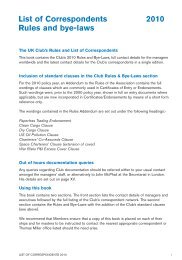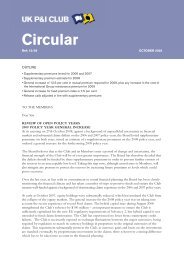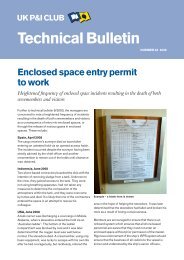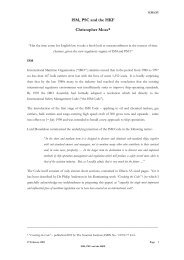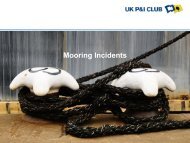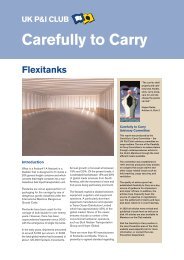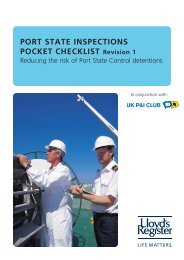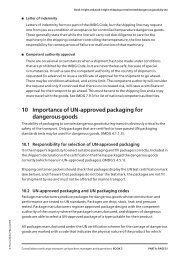Understanding Mooring Incidents - UK P&I
Understanding Mooring Incidents - UK P&I
Understanding Mooring Incidents - UK P&I
Create successful ePaper yourself
Turn your PDF publications into a flip-book with our unique Google optimized e-Paper software.
<strong>UK</strong> P&I CLUB<br />
LP News<br />
JANUARY 2009<br />
<strong>Understanding</strong> mooring incidents<br />
Major accidents involving mooring equipment in the last 20 years have injured<br />
many seafarers and have cost the <strong>UK</strong> Club over US$34 million<br />
Many of these accidents have occurred during the<br />
handling of ropes/wires, where ropes/wires have parted<br />
(53%) or where ropes/wires have jumped/slipped off<br />
drum ends/bitts (42%) with 5% caused by actual<br />
equipment failure (see pie chart below centre).<br />
Parted ropes/wires normally occur during general<br />
mooring, tug and ship to ship operations with equipment<br />
failure, misuse, wash damage and weather also playing<br />
a role. Injuries from non parted ropes/wires normally<br />
occur due to crew being caught up in ropes/wires and<br />
ropes wires slipping off and becoming jammed on drum<br />
ends during normal mooring operations (see pie charts).<br />
Whilst mooring injuries are the seventh most frequent<br />
cause of personal injuries in the Club they are the third<br />
most expensive per claim indicating how horrific some<br />
of these injuries can become.<br />
Types of incidents resulting in personal injury<br />
Equipment failure<br />
5%<br />
Hit by non parted ropes/wires<br />
42%<br />
Hit by parted ropes/wires<br />
53%<br />
Slipped off/<br />
jammed on<br />
equipment<br />
20%<br />
Caught up in<br />
ropes/wires<br />
20%<br />
<br />
<strong>Mooring</strong><br />
general<br />
60%<br />
Non parted<br />
<br />
Parted Equipment<br />
misuse/failure<br />
6%<br />
Weather<br />
related<br />
10%<br />
Tug operation related<br />
13%<br />
Wash<br />
10%<br />
Ship to ship<br />
3%<br />
<strong>Mooring</strong><br />
general<br />
58%
The worrying statistic is the apparent increase in<br />
number and value of these claims over the past 9 years<br />
(see graph below).<br />
18<br />
16<br />
14<br />
12<br />
10<br />
%<br />
8<br />
6<br />
4<br />
2<br />
0<br />
1987<br />
1990<br />
1993<br />
1995<br />
1997<br />
1999<br />
2001<br />
2003<br />
2005<br />
Number % Value %<br />
Risk assessment of mooring<br />
stations<br />
A risk assessment should be made of all mooring areas<br />
on board; looking at the space with a view of purposely<br />
searching for hazards that may cause injury. <strong>Mooring</strong><br />
areas naturally contain many trip hazards, and<br />
highlighting these is a good starting point.<br />
Hazard highlighting<br />
Physical hazards to be highlighted should not be<br />
limited to bulkhead frames, mooring bits, pedestal<br />
fairleads and cleats. It should also include structures<br />
such as platforms at the windlass and hawse pipe<br />
covers.<br />
Injuries from mooring incidents<br />
Pelvis 2%<br />
Face 3%<br />
Chest 3%<br />
Eye, Foot , Thigh,<br />
Ankle, Wrist 1%<br />
Leg 23%<br />
Hand 3%<br />
Shoulder 3%<br />
Knee 3%<br />
Arm 7%<br />
Death 14%<br />
Head 7%<br />
Multiple injury 11%<br />
Back 14%
eplaced and not simply painted<br />
over.<br />
The image (left) shows a pedestal<br />
fairlead that is well maintained.<br />
There is evidence that it has<br />
recently been turned and greased<br />
and the grease nipple on top is<br />
highlighted.<br />
In what condition is mooring equipment<br />
on board your ships?<br />
<strong>Mooring</strong> equipment<br />
that has suffered<br />
severe wastage will<br />
not perform to the<br />
certified standard.<br />
This also applies to<br />
the steel to which<br />
the equipment is<br />
welded. The image<br />
shows mooring bitts<br />
that are badly wasted. The deck is in equally bad<br />
condition and there is a danger of the bitts being torn<br />
from the deck.<br />
Snap-back zones<br />
The majority of serious incidents in mooring areas<br />
involve parting lines!<br />
Qualified seafarers are aware of the fact that a snapback<br />
zone exists when a mooring line is under tension.<br />
It is, however, a rare thing to see crew taking this into<br />
account when they are working mooring lines on deck.<br />
Headline<br />
Headline<br />
Highlighting mooring line snap-back zones ensures that<br />
crew can visibly see the danger areas without having<br />
to purposely think about them while working.<br />
When a line under tension parts, it will whip back to<br />
the remaining point of tension.<br />
Breastline<br />
Point of<br />
failure<br />
If the line can travel back in a<br />
straight line then it will do,<br />
striking anything or anybody<br />
in its path.<br />
Point of<br />
failure<br />
If the taut line is lead around<br />
a lead then it has the<br />
potential to whip round in a<br />
bigger arc, as illustrated in<br />
the second diagram.<br />
Spring<br />
If snap-back zones are painted on the deck then crew<br />
will be alerted to the danger when they notice they are<br />
standing in a highlighted zone.<br />
Painting these areas also helps supervising officers<br />
instruct crew to keep clear when lines are coming<br />
under tension.<br />
Point of<br />
restraint<br />
Snap-back<br />
zone<br />
Point of<br />
restraint<br />
Snap-back<br />
zone<br />
Diagrams on this page from MCA Code of Safe Working Practice for Merchant Seamen<br />
Pedestal<br />
roller<br />
‘old man’
Awareness of bights<br />
Trained deck hands understand the dangers of standing<br />
within a bight or coil of rope and it is therefore<br />
surprising that a significant number of personal injury<br />
incidents during mooring operations involve seamen<br />
doing just that.<br />
The diagram forms part of an investigation report into<br />
the death of an A/B who was dragged through a set of<br />
bitts by a mooring line.<br />
be present at mooring stations during mooring<br />
operations.<br />
It should be policy on board that inexperienced<br />
personnel such as cadets in the early stages of their<br />
training, who are to be involved in mooring operations,<br />
should be under the supervision and direction of an<br />
experienced seafarer. Effectively, someone should be<br />
appointed to ensure the safety of the inexperienced<br />
person, and both should be aware of who is<br />
undertaking that duty.<br />
PORT<br />
Deceased after<br />
being pulled through<br />
mooring bitts<br />
<strong>Mooring</strong> bitts<br />
Spring line<br />
STARBOARD<br />
Deceased before<br />
accident<br />
Everybody on board should be aware that only<br />
personnel directly involved in mooring operations may<br />
visit mooring stations during mooring operations. This is<br />
best done with safety notices and implementation into<br />
on board policies.<br />
The number of crew found on board is often the<br />
minimum required to safely operate the vessel.<br />
Although some ships may find themselves stretched for<br />
manpower, mooring operations should never be<br />
undertaken with less crew than is considered<br />
necessary to do the job safely.<br />
Diagrams on this page courtesy of Maritime New Zealand<br />
This incident also highlights procedural and awareness<br />
issues because the mooring party forward informed the<br />
bridge that all lines were clear when they were in fact<br />
still in the water. Nobody noticed that as the vessel<br />
was manoeuvring away from the berth, one of the lines<br />
became snagged on one of the wharf buttresses.<br />
The unfortunate seaman was recovering the line but<br />
stepped in a bight of the<br />
mooring line as it became<br />
taut and was then dragged<br />
through the bitts as the fouled<br />
line ran from the vessel.<br />
Bights don’t always look like<br />
bights. Here a seaman has<br />
inadvertently stepped over<br />
the line and put himself at risk<br />
<strong>Mooring</strong> winches<br />
Who is at the mooring station?<br />
<strong>Mooring</strong> operations are dangerous to<br />
crew on board because of the great loads<br />
that the mooring lines will carry, and the<br />
danger of them breaking while taking up<br />
this tension.<br />
Only personnel involved in mooring operations should<br />
There should always be a minimum of two people to<br />
each mooring station throughout the operation. Even<br />
where automatic mooring systems are installed, a<br />
second person should always be present in case<br />
something goes wrong.<br />
Crew should not be allowed to operate a windlass or<br />
capstan and handle the rope at the same time. This is a<br />
two person job. Fixing a lanyard to an operating lever<br />
and pulling on it from the rope-handling position should<br />
strictly be forbidden. If only two crewmembers are on<br />
deck for mooring operations then they should work<br />
together on the lines at one end of the vessel and then<br />
the other.<br />
Incident!<br />
A vessel moored alongside during cargo operations<br />
was fully laden with her deck level below the dock<br />
level. It was noticed from the quayside that the forward<br />
spring was caught under a padeye located on the ships<br />
side. The spring, a wire rope, was taut and there was<br />
concern that in this position it might break.<br />
An attempt was made to free the line by slacking and<br />
hauling it on the windlass but due to the curvature of<br />
the forward hull section, and the extremely long lead of<br />
the spring line, it would not free. The line was heaved<br />
taut in the hope that it might jerk free. When the line<br />
did free itself the tension it was under caused it to<br />
oscillate up and down, passing 5 feet inboard of the<br />
ships rail and striking a young engineering apprentice<br />
in the head.
The engineering apprentice was not involved in the<br />
operation and nobody involved was aware of his<br />
presence until after the accident. He was also not<br />
wearing a hard hat.<br />
In this incident the spring line had an extremely long<br />
lead. A bollard was available closer to the bow of the<br />
ship but this was not used. It was found that if the<br />
nearer bollard had been used then the line would<br />
probably still have become caught under the padeye,<br />
but it is unlikely that it would have jumped inboard of<br />
the ships rail upon freeing from the padeye.<br />
This incident highlights the need for control over<br />
people present at mooring stations, the wearing of PPE<br />
and efficient mooring arrangements.<br />
<strong>Mooring</strong> arrangements<br />
Bad mooring arrangements can also be responsible for<br />
claims for damage to cargo handling equipment, docks<br />
and other structures. In these incidents it is often the<br />
case that the vessel surged extremely or broke her lines<br />
because of strong currents or the influence of passing<br />
vessels.<br />
The image below shows a vessel considerably<br />
overhanging her berth. She is therefore unable to lead<br />
any stern lines aft of the ship. The image shows one<br />
line in particular being lead an extremely long distance,<br />
rendering it pretty much useless.<br />
Personal Protective Equipment<br />
(PPE)<br />
When struck on the head<br />
by a parting mooring line,<br />
the wearing of a hard hat<br />
will be the life or death<br />
deciding factor. A hard hat<br />
should be worn at all times<br />
when involved in mooring<br />
operations, as well as appropriate safety footwear and<br />
boiler suit (or other protective full-length clothing).<br />
It has been the general opinion on some vessels that<br />
the wearing of gloves when handling mooring ropes is<br />
an unsafe practice. This is due to concern that loose<br />
gloves may become trapped under a line on a windlass<br />
drum and haul the crewmember over it. Gloves should<br />
be worn but crew need to be aware of the dangers<br />
associated with ill-fitting gloves when handling ropes.<br />
The ship has correctly put out as many lines as possible<br />
but should also consider the use of the anchor and<br />
mooring lines running aft from either the main deck or<br />
other suitable areas. In situations like this it is important<br />
to analyse local tidal and weather patterns in order to<br />
predict how the vessel will be affected. The vessel<br />
owners should be informed and cargo operations<br />
stopped (or not commenced) if conditions do not<br />
appear safe.<br />
The photo below shows a chart that highlights the<br />
compulsory PPE to be worn for various operations on<br />
board. This can be devised on board and is a very<br />
useful aid to crew when posted in changing rooms or<br />
mess areas.<br />
The following image shows insufficient mooring<br />
arrangements ashore and the vessel is forced to pay<br />
out an extremely long lead on the stern lines. In this<br />
event, the master should protest to the port authority,<br />
take photos and inform the owners.
<strong>Mooring</strong> practices<br />
Professional seafarers must be monitored during<br />
mooring operations to ensure they do not become<br />
complacent in their work; putting themselves and<br />
others in a dangerous situation.<br />
Deck officers monitoring mooring operations must be<br />
actively watching for hazards and give instructions to<br />
ensure hazards are controlled.<br />
<strong>Mooring</strong> operations should be conducted in a safe<br />
manner. In the image below:<br />
Consult an on board seamanship manual for proper<br />
seamanship practices.<br />
Wire to rope<br />
A rope mooring line should<br />
never join a metal line<br />
without the use of a thimble.<br />
The condition of the rope and<br />
wire in this example is poor<br />
and the lack if a thimble<br />
increases the likelihood of the rope breaking.<br />
●<br />
●<br />
●<br />
The line on the windlass drum is being handled<br />
safely. The crewmember at the drum is keeping his<br />
hands clear of the turns and positioned so as not to<br />
become fouled in coils of rope.<br />
The crewmember operating the windlass has a good<br />
line of sight of the rope and the man handling it.<br />
Both crew are appropriately attired in correct<br />
personal protective equipment.<br />
An eye in the end of a wire<br />
If it is necessary to create an eye in the end of a wire,<br />
then it would be worth investing in crimping equipment.<br />
Many ships prefer the use of bulldog-grips for creating<br />
an eye in the end of a wire rope, but there is a correct<br />
way of doing this:<br />
●<br />
An allowance of 150 mm should be made between<br />
the last bulldog grip and the end of the ‘dead’ wire.<br />
It is important to ensure that the lashing wires are<br />
not cut short immediately next to the bulldog grips.<br />
✘<br />
Correct use of stoppers<br />
<strong>UK</strong> Club ship inspectors often notice when boarding<br />
Club vessels, that stoppers have been left on lines<br />
after they have been secured. This bad practice puts<br />
unnecessary strain on the<br />
stopper as the line<br />
continues to tighten on<br />
the bitts. It may also result<br />
in the stopper rope<br />
tightening to the point<br />
where it can’t be<br />
released.<br />
The second image (right) shows<br />
a chain stopper setup for use<br />
with polypropylene ropes. Only<br />
rope stoppers should be used<br />
with rope mooring lines; chain<br />
stoppers are for use with wires.<br />
●<br />
●<br />
✔<br />
Bulldog grips have a grooved surface in the bridge<br />
piece which is suitable for a standard wire of righthand<br />
lay having six strands. Crosby grips have a<br />
smooth surface in the bridge piece. The grips should<br />
not be used with ropes of left-hand lay or of different<br />
construction.<br />
The first grip should be applied close to the thimble<br />
or at the neck of the eye if a thimble is not used.
●<br />
Other grips should be placed at intervals of at least<br />
one clear grip (albeit a distance of six rope diameters<br />
apart is suggested) between each other.<br />
The grips must all face in the same direction and<br />
must be fitted with the saddle or bridge applied to<br />
the working or hauling part of the rope. The U-bolt<br />
must be applied to the tail or dead-end of the rope. If<br />
the grips are not applied as indicated above, the<br />
effectiveness of the eye can be seriously affected.<br />
stowed off the deck and if possible away from<br />
precipitation and direct sunlight. If baskets or other<br />
storage devices are not available then ropes should be<br />
coiled down on pallets (see below).<br />
Secure to bitts<br />
Windlass drums are not designed for taking the weight<br />
of mooring lines for a long period of time. If windlass<br />
drums are used for this purpose then over a period of<br />
time they will suffer damage and be in need of repair.<br />
Ropes correctly stowed off deck<br />
This windlass drum suffered bearing damage and is being<br />
overhauled<br />
Ropes badly stored on wet deck<br />
Over time, ropes and wires will suffer wear and<br />
damage and the general condition will be evident in the<br />
rope as a whole. But a part of the rope may become<br />
particularly damaged at any time and it is important to<br />
check the rope at every opportunity.<br />
Once ropes have been hauled tight they should be<br />
secured to bitts as in the good example on the left<br />
Care and maintenance of ropes<br />
In order to preserve the usage life of ropes, ensure they<br />
are protected from the elements and not subjected to<br />
unnecessary chaffing.<br />
Do not store ropes on wet decks. Ensure they are<br />
A visual inspection should be performed every time<br />
before, during and after a rope has been used.<br />
Flaking a rope on the deck ready for running is a good<br />
opportunity to look for damage which a part of the rope<br />
may have suffered, causing a weak point in the rope.<br />
A general visual inspection can also be performed by<br />
the person handling the line on a windlass drum as it is<br />
received, hand over hand.<br />
<strong>UK</strong> P&I CLUB<br />
IS MANAGED<br />
BY THOMAS<br />
MILLER<br />
For further information please contact:<br />
Loss Prevention Department, Thomas Miller P&I Ltd<br />
Tel: +44 20 7204 2307. Fax +44 20 7283 6517<br />
Email: lossprevention.ukclub@thomasmiller.com




